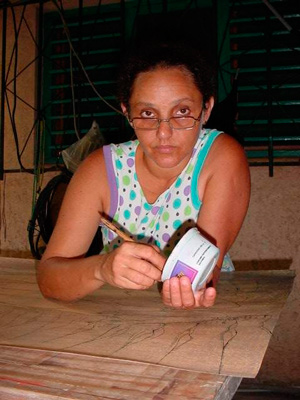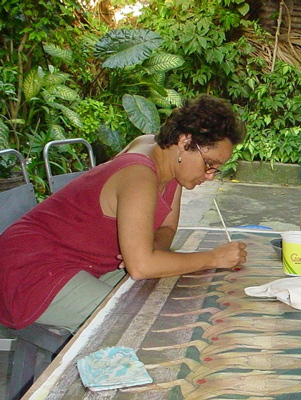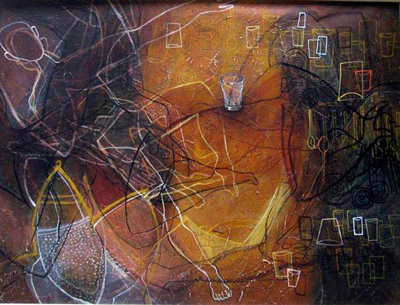Cuban Artist Eidania Perez Interviewed
Helson Hernandez

HAVANA TIMES — Cuban painter Eidania Perez offers us a glimpse at her artistic and spiritual milieu, allowing us to discover some of the concerns that impel her creative work. “I take my work as an artist and a conveyor of certain values very seriously. I have huge respect towards art and the gift of creation,” she told Havana Times.
HT: What art-form do you devote the most time to?
Eidania Perez: What I do the most within the diverse and fascinating world of art is basically painting, the discipline I graduated in at Cuba’s Higher Institute for the Arts (ISA) in 1984. I’ve delved into other arts, such as decoration, interior and wardrobe design, book illustration and drawing. This last one is a strong component of all my works, no matter what the format. I’ve also done sculptures and engravings, something I am actually doing right now, with the support of Havana’s Experimental Graphic Design Workshop. Engraving is a fantastic, enigmatic and attractive art-form that encourages flights of fancy and creativity – it is very stimulating.
HT: Are there any recurrent motifs in your works?
EP: I have always been preoccupied with the human condition, with the values that set us apart from other living beings. These values are increasingly distorted by human beings themselves, and we are all victims of such practices – even when we are responsible for them. I am interested in leaving my mark – I don’t care if I achieve it in my lifetime or afterwards, if it’s insignificant or not – something that will make people think in addition to causing pleasure and enjoyment, something that both appeals to the senses and prompts reflection. I am a hard-working artist and I devote a lot of time to my ideas, such that the message gets across in a more or less subtle manner.

HT: How would you describe the result of your creative work visually?
EP: Visually? It’s very much in tune with the way I see and feel things, with how I express and get my creative intentions across. The work changes and evolves in step with the aesthetic and conceptual presuppositions that inform me or that have flourished as a result of my need to express myself through these media, which are ultimately my means of communication and of relating socially. It is also shaped by my aims and the need to convey my ideas and views, as well as the intention of bringing my work closer to those who surround me and of documenting this experience.
The distinctive seal of my work, almost invariably, is the contrast between visual discourses, highly contentious and realistic elements, and the forwardness of expressionist motifs, portrayed as the duality that characterizes everyday life, people’s doubts, successes and failures. This came about at a specific moment and I have tried to preserve it as a distinctive seal of my work. It is basically rooted in my way of conceiving the duality of life, that which generates the changing and moving spirit of things, that which never stops – for better or for worse.
HT: If you were asked to associate your work with a specific mood, which would it be?
EP: My mood is constantly shifting between work and thought, but concrete action always takes the lead. I am a mixture of Michelangelo’s David and Rodin’s Thinker – though sometimes, simple mortal and human that I am, I fail in my efforts. I am very objective, but I also like to meditate and – why not – reflect on things. That is why I enjoy teaching so much, but only there where I can do it with the respect and freedom needed to get the best out of those individuals who deliver themselves to us so that we may shape them, for the aesthetic and reflective good of our human societies.

HT: What do you think is the responsibility of a female artist in contemporary Cuban society?
EP: To express her devotion and efforts to defend her skills as an artist and in other fields. From the very beginning, women have borne the gift of creation in their apparently weak bone and muscular structures, the only place where the sap of existence can come to be. This makes her the absolute repository of life itself, even though she requires an external seed to materialize such life. This is women’s special gift. What, then, could we not take on? As Jose Marti said, “When a cultivated and virtuous woman anoints a work with the honey of her affection, that work is indestructible.” This is how I conceive of the artistic work of Cuba’s female artists, adding that such work often involves great sacrifices, because most women bear the additional burden of their roles as mothers – and Cuban mothers tend to be very protective of their children.
HT: Tell us about an exhibition that has had an impact on your development as an artist.
EP: In my nearly 30 years of work as an artist and teacher, I haven’t had a single solo exhibition that hasn’t been moved by very concrete interests. As such, there haven’t been many, as many as I’ve needed, and they all have the same importance for me. All of them have had an impact on me and on many people who follow my work as well.
I regret that many people don’t know of many of them, because all have had something to say (even though, at first, some didn’t understand my work). I take my work as an artist and a conveyor of certain values very seriously. I have huge respect towards art and the gift of creation. We must respect art for, though it is true it has earned a decorous place within society, it is also true that many mistakes are made in terms of the publicity given certain artistic products, mistakes that distort the good and noble intentions that nourish the work from the start, as a catalyzer of social values and representations.

HT: Does art run in your family?
EP: I don’t know of any distant relatives who were artists, I only recall an uncle on my father’s side who sang peasant music with singular charm, devotion and intuitiveness. In my immediate family there’s my husband Alfredo Martel, a sculptor with a solid and thoughtful oeuvre, and my daughter, Camila Martel, a violinist with the Camerata Romeu and the ISA orchestra attached to Havana’s Lyceum Mozartiano, a tireless and conscientious student – and a woman.
So far, I’ve had the good fortune of being able to enjoy her achievements, which require no less dedication and devotion, for these careers demand a lot of time, and none of us have much of it, not even for the daily activities we cannot ignore. This gives us the energy to continue to make our art and leave our marks. Living in this family entails great responsibility, a difficult, enticing and pleasurable exchange and a fruitful, healthy and rewarding degree of competition which makes us better professionals and – no doubt – better human beings, despite the sacrifices this demands of all of us.
HT: What are your current artistic interests?
EP: As a woman and as an artist, what I wish for the most is to continue to be alive to continue developing my work with modesty and sincerity, to continue to support my daughter in her efforts to reach higher and more elevated grounds – so that all of us, as a family, can respectfully leave behind a noble legacy for humanity for Cuban and world culture.

Nice work